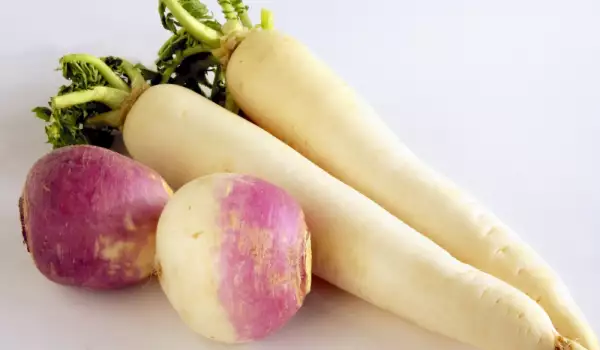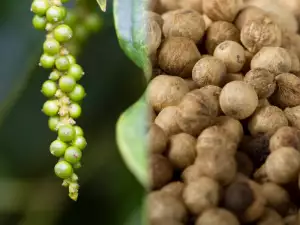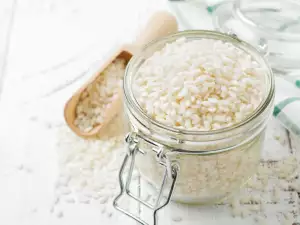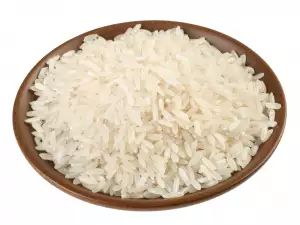White turnip is a root plant that belongs to the Brassicaceae family. It is the family of radishes, cabbage, cauliflower, horseradish and other plants. This plant originates from Asia, but is widespread in many places in the world.
The different varieties of the white turnip are characterized by a variety of sizes and shapes. In some varieties, the root is elongated, reminiscent of a carrot. Others have a rounded root. What they have in common is the white color of the root, which is the edible part of the plant. In addition, in all varieties, the root has a crunchy consistency.
When fresh, it has a nice, slightly spicy flavor and is mostly used in recipes for fresh salads, as it doesn't do well with heat treatment. The white turnip is preferred over the black turnip, because it is not as spicy and its flesh is considerably more tender. On the other hand, its black relative surpasses it in essential oil content. It is also believed that the black turnip has more pronounced healing properties.
Composition of white turnip
White turnip is a valuable source of many nutrients and vitamins. The composition of the plant contains a small amount of saturated, polyunsaturated and monounsaturated fats. White turnip is a source of fiber, protein and water. In addition, white turnip has calcium, iron, phosphorus, magnesium, manganese, selenium, copper. The content of the root vegetable contains vitamin B1, vitamin B2, vitamin B3, vitamin B6.
History of white turnip

The roots of the white turnip are in Asia and more specifically in China. It has been cultivated in the country for thousands of years. It spread to Egypt, Rome, Greece, Japan. Over time, a wide variety of varieties have appeared. It is not clear exactly when it reached our country, but certainly farmers have been growing it for centuries.
It remains a preferred guest at the table because of the crispy flesh, which is used as an appetizer. It has also long been used as a cure for colds and flu conditions.
Selection and storage of white turnip
You can grow white turnips yourself or buy them from a store. Fortunately, this product is widely available on the market and very easy to find. The white turnip is a preferred vegetable, because of its beneficial properties, but also because of its durability. In case you get a certain amount of this natural wealth, you can store it in some cool and dark place. If the individual turnips are placed on straw, spaced apart from each other, they can retain their freshness for weeks.
Cooking white turnips
The white turnip is mostly consumed fresh. It is actively involved in the cooking of many countries. In Japan, for example, it appears as a component of a variety of pickles. It is also included in some sauces. Interestingly, in the land of the rising sun, the leaves and sprouts of the vegetable are also used for culinary purposes. In China, white turnip consumption is also widespread. In local specialties, it is mixed with rice flour, eggs, onions, garlic, bean sprouts, etc.
It is used in salads, in which carrots and cabbage can be present. They are flavored with olive oil or oil and a little vinegar is added. This, of course, is the simplest option for serving the vegetable. It can also be combined with apple, orange, beetroot, cucumbers, peppers, avocado. The resulting salads are extremely light and dietary, but at the same time they are a real vitamin bomb during the cold months.

Benefits of white turnip
Eating white turnip is beneficial for a number of reasons. It acts antibacterial and antiviral. That is why its consumption is especially recommended during the winter months, when we are at great risk of colds and flu. The juice of the miracle root vegetable contains enzymes. This natural gift has a beneficial effect on the digestive system and supports the processes it carries out.
White turnip is a proven remedy against constipation and lazy bowels. It is used very often in respiratory diseases, because it helps to easily separate the stringy secretion stuck in the lungs. In folk medicine, it is recommended for bronchitis and flu. In addition, white turnip has a positive effect on the kidneys, helping to release unnecessary water more easily. According to some folk beliefs, turnips also help to reduce weight.
The vegetable strengthens the liver cells and protects them from the dangerous action of toxins. Many studies show that turnips are a source of some anti-cancer substances, so that's another good reason to eat the root vegetable. It is also believed that this vegetable has a good effect on bones and eyesight.
White turnips are highly valued in Chinese traditional medicine. According to local beliefs, during the winter season it has stronger healing properties than even ginseng. According to Chinese healers, in order to be healthy, a person should consume white turnips in winter and ginger in summer.




















Comments